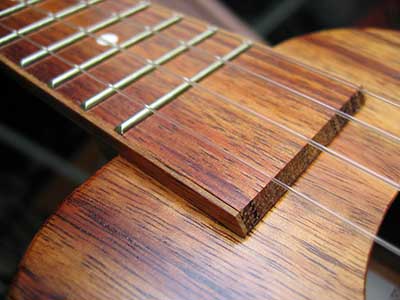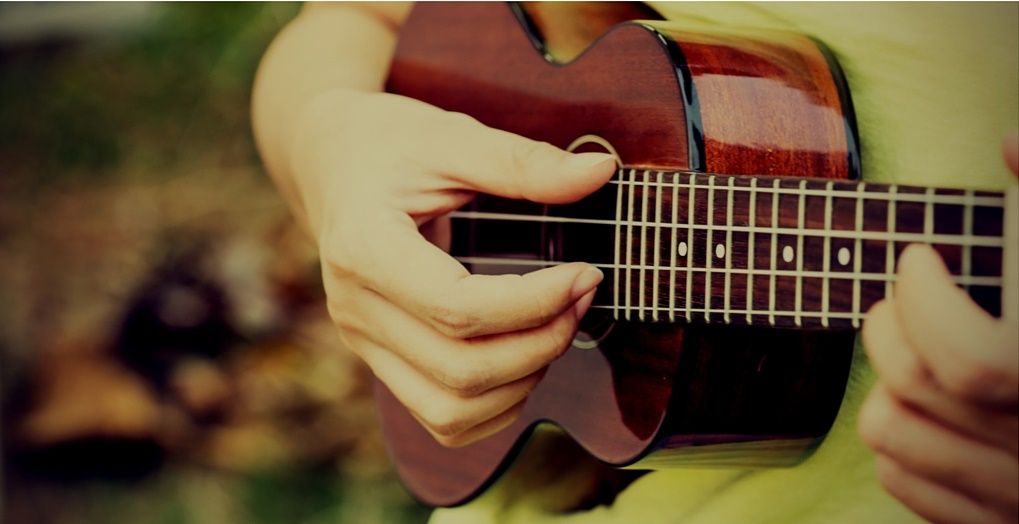Barre chords are some of the hardest chords to master. Once mastered, you unlock an entirely new selection of chord variations. This adds variety to your plain Jane, boring chord progressions. We are going to be talking all about ukulele barre chords, what they are, why you use them, and how to use them.
[tcb-script id=”mNCC” language=”javascript”]medianet_width = “600”;medianet_height = “250”;medianet_crid = “712534424”;medianet_versionId = “3111299”;[/tcb-script][tcb-script src=”//contextual.media.net/nmedianet.js?cid=8CU7GM763″][/tcb-script]
What is a barre chord?
Barre chords can be used on any string instrument. A barre (or bar) chord is when you use one finger to press down on multiple strings on the uke fretboard. Usually, this is done with your index finger, but there are some tricky chords that require you to use your other digits.
Why should I use barre chords?
You can use barre chords to play a chord that isn’t restricted to the tones of the uke’s open strings. Barre chords are used in all genres of music. Barre chords are also called “moveable” chords. This is because the chord shape is the same up and down the neck of the ukulele.

Barre chords offer a different tone to your chords and make the music more interesting. When you play a barre chord the tone is going to change compared to an open or unfretted string.
Instead of using a capo on your ukulele, which is sometimes difficult to find, you can incorporate barre chords. For example, if a song is played with a capo on the first fret and you are playing A major, you can toss the capo and play a B flat or an A sharp.
How do I play barre chords?
Barre chords can be difficult to switch to and fret. It may take you quite a bit of practice before you can master barre chords on the ukulele. But, why learn the hard way? We are going to walk you through some steps that can make ukulele barre chords easier.
1. Put the middle of your thumb on the back of the fretboard, it’s ok if it sticks out a little bit. This will help you apply pressure to the strings when you use your barre chord finger.
2. Try to press down as close to the fret as possible. This will ensure you are getting the proper leverage against the strings and each string will ring out more clearly.
3. Use a full barre. Some chords like B flat require you to only barre two strings instead of all four. Go big, or go home and go for the full barre. I think it makes it easier to get the right amount of pressure, especially when you are just getting the hang of it.
4. When you can, double the barre. This won’t work for every chord, but sometimes it’s helpful to place your middle finger behind your index finger when playing a barre chord. This will make your barre chords stronger and ring out clearly.
5. If you have dead notes, try to isolate which notes aren’t ringing out. You can do this buy plucking each individual string. Once identified, you can play around with your positioning to get the best angle.
6. Keep practicing! It takes awhile to master barre chords. They require a good amount of strength from your fretting hand. You can work on finger exercises to build up your strength.
Here are some common ukulele barre chords:


Remember, barre chords are tricky! Don’t give up on them. It will be a process to learn and master ukulele barre chords.
[tcb-script async=”” src=”//pagead2.googlesyndication.com/pagead/js/adsbygoogle.js”][/tcb-script][tcb-script][/tcb-script]
If you need a little ukulele inspiration, watch this video of Taimane Gardner, the Ukulele Virtuoso, play at TedxMaui. Taimane translates to diamond in Samoan. She plays everything on her ukulele from classical to rock to flamenco. Taimane takes the ukulele to bounds you may never have thought of. Her performances and stage presence is incredibly captivating, I can’t stop watching them!







Wonderful inspiration